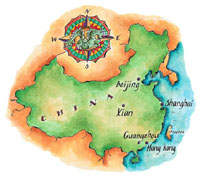As China modernizes its economy, it continues to struggle with the legacy of its bloated, inefficient state-owned enterprises – companies that once controlled entire industries and still play a significant role in China’s economic and political life.
China boosters say that SOEs are being swept aside as Chinese entrepreneurs create new businesses and Western companies pour money into Chinese plants and joint ventures. But critics suggest SOEs still have a chokehold on broad swaths of China’s economy and, unless they are reformed, will eventually stifle the country’s economic gains.
Wharton’s China Business Forum brought together a cross-section of executives and experts to discuss the role that SOEs will play in China’s future. Speakers included the president of one of the country’s most successful SOEs as well as two professors who have studied the rule of law in China.
Conference participants couldn’t agree on an appropriate role for the SOEs, or even if they should continue to exist at all. But they did agree that SOEs should be rapidly modernized if China wants to keep attracting the foreign investment that is critical to its future.
Ren Jianxin is president of China Bluestar Group, a chemical maker and industrial conglomerate which he and seven colleagues started in 1984. Over the last 19 years, it has grown by swallowing up 70 other SOEs. Today, it even controls 500 fast-food outlets.
Jianxin acknowledged the SOE sector’s problems – over-regulation, ponderously slow decision-making, operational inefficiency – but argued that SOEs remain the best option as partners for Western companies looking for business in China.
SOEs “have access to land, labor and resources, and they are still dominant in many industries with high barriers to entry,” he said. “Think of an SOE as a sick patient, and a new company as a healthy baby. It’s much easier to cure a sick patient than to raise a baby.”
And even more important, SOEs offer the quickest entrée to a surging economy, he said. “In the year 2002, China’s gross domestic product was No. 5 in the world. Its foreign currency reserve was No. 2 in the world. China is using more and more advanced technology. Five years ago, it had 83.5 million fixed phone lines and mobile phones. Today, it has 421 million – that’s first in the world. Motorola must be making big money in China, but so are McDonald’s and Kentucky Fried Chicken,” he quipped.
At least one country – South Korea – made an early bet on doing business with China and its SOEs, and is already reaping big rewards, Jianxin said. Its success belies prejudices about China being far more interested in exporting its goods than giving other countries access to its markets, he argued.
South Korea has a $20 billion trade deficit with China, Jianxin pointed out. In 2002, mobile-phone trade between the two countries was $60 billion. “Why is Korea, with its small population and small land, making big money in China? The Koreans attach more importance than other countries to understanding China. They have put aside ideology to make money there.”
Of course, such a policy makes sense for South Korea, given its proximity to China and its relative isolation. A small nation at the tip of the peninsula (about the same size as Indiana), South Korea borders its archenemy, North Korea, and lies across the Yellow Sea from China. What’s more, its pro-China economic policy can also be seen as a foreign policy designed to undercut China’s traditional ties with communist North Korea.
Social Dislocation
Stephen Goldmann, former chairman of ExxonMobil China, has worked extensively with SOEs as his company has tried to expand its China operations, an experience that has made the oil-industry executive a realist about the company’s prospects. He said they have made strides but have a long way to go. “The oil industry is what the Chinese government defines as a pillar industry,” he noted. “Therefore, you’re dealing with major SOEs at the Beijing level. Progress has been slow and difficult. There have been many attempts to establish joint ventures in chemical refining, for example, and projects are only now getting under way. We have one that will come out of the ground in the next year or so.”
The problem, Goldmann argued, is that Chinese leaders “still fundamentally distrust markets.” In dealing with ExxonMobil, for example, officials in Beijing wanted to tell them where to build its chemical plants, while ExxonMobil wanted to put them where it saw demand for their products.
At the same time, Chinese officials already have begun to reform their oil exploration and refinery industry, Goldmann said. Historically, the industry’s SOEs were divided by function. After a 1998 restructuring, they are divided by region, and China is moving them to what Goldmann called “controlled competition.” “The reforms are working,” he said. “The SOEs are becoming leaner and more transparent. They are benchmarking, looking at what oil refineries abroad are doing. They are developing market-driven strategies. They are learning from joint ventures with foreign companies.”
But many problems remain, and some of them can’t be solved with better accounting systems and more competition. Northern China, for example, has too much oil-refining capacity, while the south has too little. But the government can’t just close the refineries in the north and open new ones in the south because of the social disruption that would cause. “In some communities in the north, it’s the only business,” Goldmann said.
“My conclusion is that China is off to a great start, but it will be a long process for western companies to gain access to its markets. Project approvals for pillar industries remain complex and slow.”
One problem Goldmann highlighted that other conference speakers did not address was the growing gulf between China’s fast-developing, heavily populated east and its rural, rugged west. The west, he explained, has plenty of raw materials but few people and few jobs besides subsistence farming. And farmers are eager to move to the booming east. The west also has little water; its landscape is dominated by high mountain ranges and the huge Taklamakan Desert.
“One hope was that the west might be the next Saudi Arabia, but its oil reserves turned out to be smaller than expected and tough to deal with.” For the region to participate in China’s boom, Beijing will need to invest heavily in infrastructure, especially roads and railways, Goldmann said.
Too Many Workers, Too Few Jobs
Tim Weckesser, president of Science Center International, a consultancy in West Conshohocken, Pa., picked up on the social dislocation that SOE reform has caused. Despite all of China’s growth, he said, its unemployment rate is rising. In 2002, for example, the economy grew by 8% and created 8.4 million new jobs. It needed 10 million.
Why is joblessness increasing? “Migration to the cities and the decline of the SOEs – there are more new entrants into the workforce each year than there are new jobs,” Weckesser said. “China needs to create close to 20 million new jobs a year.” The U.S. Central Intelligence Agency estimates that 80 million to 120 million Chinese peasants are caught in a netherworld between rural and urban life. They have left farms but can only find part-time work.
For all China’s modernization, SOEs still control about $1.3 trillion in assets, yet 40% of them lose money, Weckesser added. China’s leaders realize that’s a problem, Weckesser noted, and are working, with mixed success, to either merge poorly performing SOEs with more successful ones, sell them off or close them. Among their successes are the power industry, where they have been able to create competition, and the telecom industry, which, because it’s new, they have rolled out with competition. “You could argue that they have done it more intelligently than the West,” Weckesser said.
Eric Orts, a Wharton professor of legal studies and management, didn’t share Weckesser’s confidence about China’s ability to reform the SOEs. He argued that the country will face a grim future if it doesn’t. “Almost all of China’s growth has been in private enterprise but almost half the economy is still state-owned. The problem with the SOEs is that they play a huge welfare role in the economy. But if the SOEs and the state are allowed to continue to control and regulate the economy, growth will stop.”
And getting rid of the SOEs isn’t the only reform needed, Orts said. China’s companies need better accounting systems and greater financial transparency. And its leaders must embrace the rule of law and recognize basic economic rights. They have made progress in recognizing the right of independent business to enter into contracts. But elsewhere they lag. “You still need a license to go into business,” Orts pointed out. “You don’t have the legal right to be an entrepreneur.”
Arthur Waldron, a University of Pennsylvania professor of international relations, was even tougher in his criticisms. “There are things we don’t like to admit about China’s leadership and policies. It’s corrupt from top to bottom. And there’s no rule of law, only men.”
So far, Westerners have not forced China to make a choice between its sometimes anti-Western foreign policy and its pro-Western economic policy, he argued. Western businesses flock to China, hungry for its huge market and cheap labor, while western governments fret over whether the country is supplying arms and economic aid to rogue states such as North Korea. “The third rail of China these days is how economic policy and foreign and security policy are on different tracks,” Waldron said. “And for 20 years, it’s been possible to avoid a critical issue – that is, the degree to which our trade with China undermines our security.”


